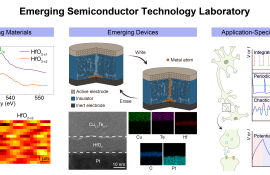- * 프린트는 Chrome에 최적화 되어있습니다. print

차세대 반도체 기술 연구실(ESTL)은 차세대 반도체 소재/소자 및 컴퓨팅 시스템 연구에 중점을 두고 있습니다. 새로운 컴퓨팅 패러다임(뉴로모픽 컴퓨팅, 인메모리 컴퓨팅, 확률 컴퓨팅 등)을 실현하기 위해, 신소재, 소자 구조, 스위칭 메커니즘, 컴퓨팅 시스템 연구를 종합적으로 수행하고 있습니다.
The Emerging Semiconductor Technology Laboratory (ESTL) focuses on developing next-generation semiconductor materials/devices and computing systems. We explore novel materials, device architectures, switching mechanisms, and system-level designs to enable new computing paradigms (neuromorphic computing, in-memory computing, probabilistic computing, etc.).
Major research field
차세대 반도체 재료 및 소자, 차세대 컴퓨팅 시스템 (뉴로모픽 컴퓨팅, 인메모리 컴퓨팅, 확률 컴퓨팅 등) / Emerging semiconductor materials and devices, emerging computing systems
Desired field of research
반도체 재료 및 소자 / Semiconductor materials and devices
Research Keywords and Topics
차세대 반도체 재료 및 소자, 차세대 컴퓨팅 시스템 (뉴로모픽 컴퓨팅, 인메모리 컴퓨팅, 확률 컴퓨팅 등), 나노전자소자
Emerging semiconductor materials and devices, emerging computing systems (neuromorphic computing, in-memory computing, probabilistic computing, etc.), nanoelectronics
Research Publications
∙ Localized Conduction Channels in Memristors. Chemical Reviews, 125, 294-325 (2025)
∙ Role of Heat in Post-Silicon Electronics. Applied Physics Reviews, 12, 031323 (2025)
∙ True random number generation using the spin crossover in LaCoO3. Nature Communications, 15, 4656 (2024)
∙ Tunable stochastic memristors for energy-efficient encryption and computing. Nature Communications, 15, 3245 (2024)
∙ Memristors with Tunable Volatility for Reconfigurable Neuromorphic Computing. ACS Nano, 18, 17007-170
∙ Heterogeneous reservoir computing in second-order memristors. Nanoscale Horizons, 9, 427-437 (2024)
∙ Probabilistic computing using Cu0.1Te0.9/HfO2/Pt diffusive memristors. Nature Communications, 13, 5762 (2022)
국가과학기술표준분류
- ED. 전기/전자
- ED04. 반도체소자·시스템
- ED0405. 반도체 재료
국가기술지도분류
- 정보-지식-지능화 사회 구현
- 010400. 반도체/나노 신소자 기술
녹색기술분류
- 고효율화기술
- 전력효율성 향상
- 323. 그린 IT기술
6T분류
- IT 분야
- 핵심부품
- 010114. 고밀도 정보저장장치 기술




